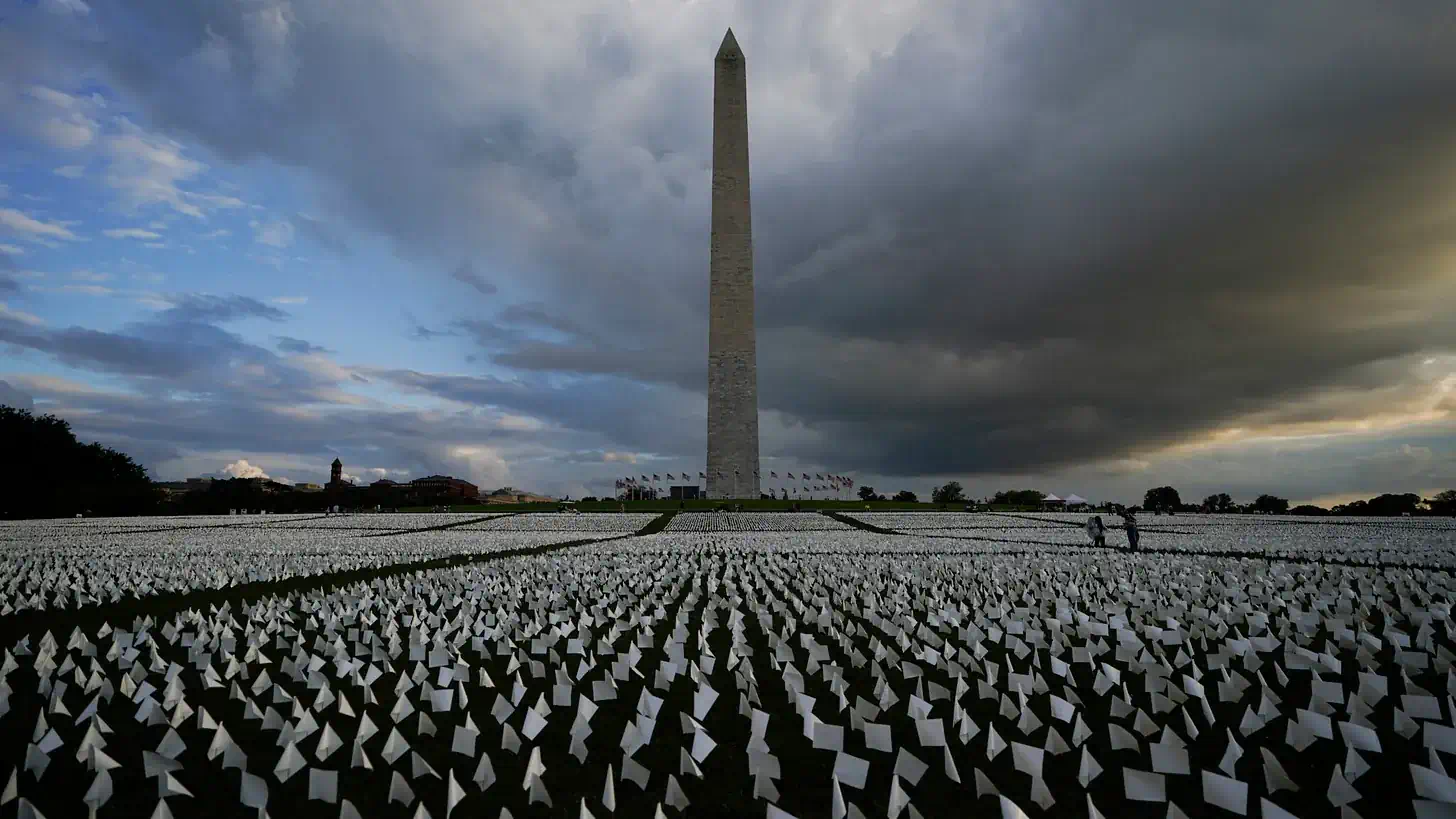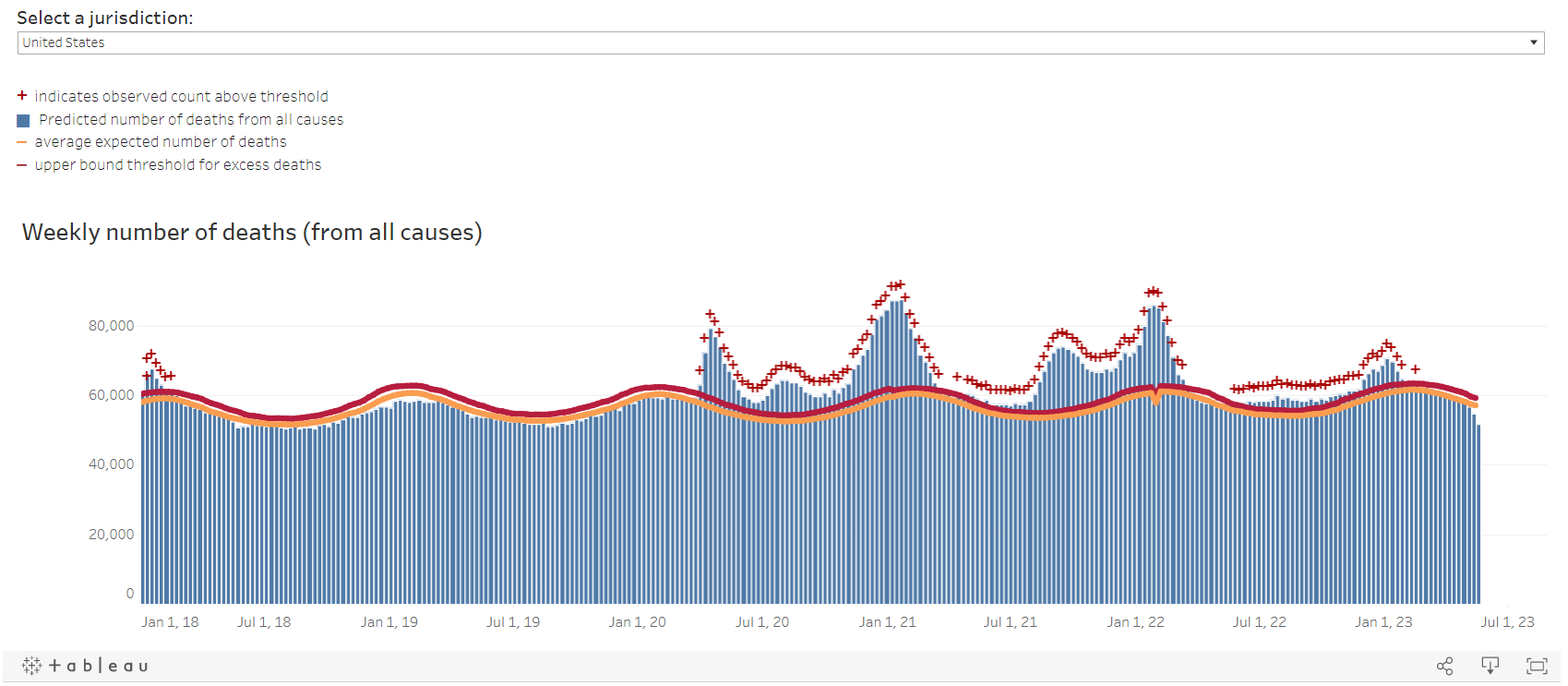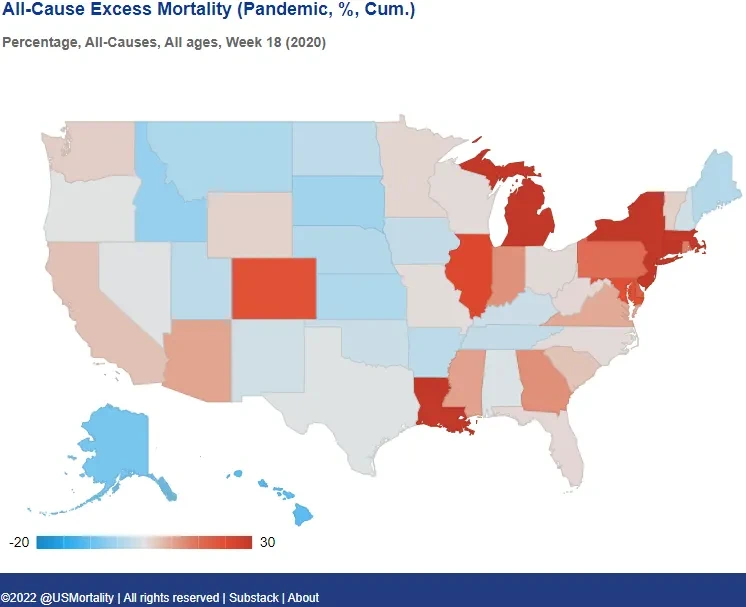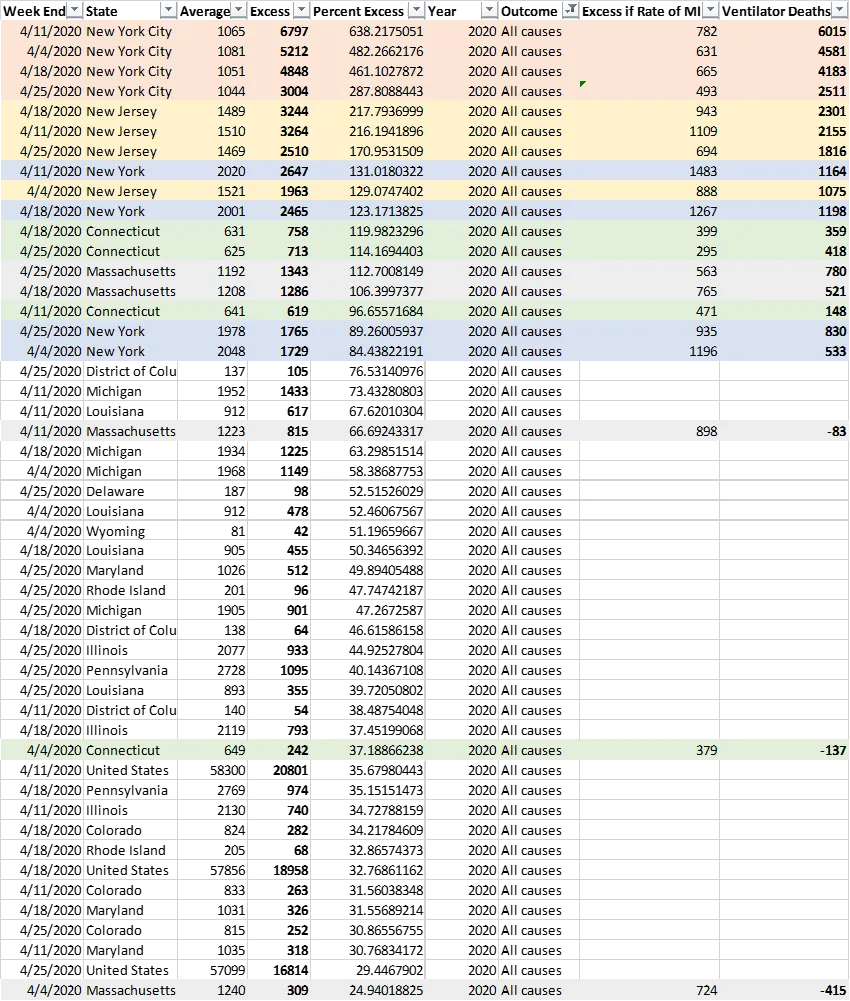Reexamining excess deaths during peak lockdown


To date, we still don’t have especially good studies on the actual causes of excess deaths by state and country when the world first went into lockdown in spring 2020.
For political reasons, these deaths were all generally been lumped together as “Covid deaths,” but this coding was appallingly sloppy. According to the World Health Organization’s initial coding guidance, if a decedent had either tested positive—using a PCR test later confirmed by the New York Times to have a false positive rate over 85%—or been in contact with anyone who had within several weeks prior to their death, then the death should be classified as a “Covid death.” This enormous number of “Covid deaths” was obviously belied by the fact that many places reporting those “Covid deaths,” such as Maine, actually had no excess deaths to speak of.
Thus, this article reexamines data from the US CDC on all-cause excess deaths by state during peak lockdown in April 2020 using the information we now know to determine what actually caused them.
This examination concludes that, contrary to popular belief, there was no uniquely deadly strain or variant emanating out of New York in spring 2020; this is clear from the fact that several states close to New York such as Vermont, New Hampshire, and Maine experienced little to no excess deaths during that time period.
On the contrary, over 30,000 Americans appear to have been killed by mechanical ventilators or other forms of medical iatrogenesis throughout April 2020, primarily in the area around New York.
This result is not altogether surprising, as subsequent studies revealed a 97.2% mortality rate among those over age 65 who were put on mechanical ventilators in accordance with the initial guidance from the WHO —as opposed to a 26.6% mortality rate among those over age 65 who weren’t put on mechanical ventilators —before a grassroots campaign put a stop to the practice by the beginning of May 2020.
As one doctor later told the Wall Street Journal, “We were intubating sick patients very early. Not for the patients’ benefit, but in order to control the epidemic… That felt awful.”
To put this in perspective, patients over age 65 were more than 26 times as likely to survive if they were not placed on mechanical ventilators .

Weekly Excess Deaths by State in April 2020
Below are all-cause excess deaths and percentage of all-cause excess deaths per capita (“Percent Excess Estimate”) by state for each week of April 2020. All data used in this examination is obtained from “National and State Estimates of Excess Deaths,” available on the US CDC website at “Excess Deaths Associated with COVID-19.”
Here’s the CSV file: Excess_Deaths_Associated_with_COVID-19
(Note: Although many of these hospitalizations and deaths may have actually occurred in March 2020, due to time lag in reporting, the vast majority were recorded in April 2020. Thus, April 2020 provides the most consistent and robust data set. After April 2020, excess deaths taper off significantly.)

The first pattern that emerges from this data is a clear correlation between population density particularly in low-income areas, cold weather, and excess deaths per capita.
For example, percent excess deaths were high in Michigan and Illinois, both of which are cold states with fairly dense and relatively poor urban centers. Percent excess deaths were likewise high in Louisiana, a warm but especially poor and dense state. Percent excess deaths were also somewhat high in Wyoming, a sparse but very cold state. By contrast, percent excess deaths were relatively low in California and Florida, both of which are somewhat dense but also warm and relatively rich states.
A clear cluster forms at the top of the chart in the area around New York City, with New York, New Jersey, Connecticut, and Massachusetts generally experiencing the greatest percentages of excess deaths per capita for each week of April 2020. To be sure, each of these four states is a cold state with dense low-income areas, which goes a long way to account for their high excess deaths. However, outside of those four states, excess deaths per capita fall into a more normal range.
It may be tempting, therefore, to conclude that a particularly deadly strain or variant emerged around March 2020 in New York and began emanating from there, which was generally the mainstream narrative at the time.
However, the idea that a particularly deadly strain or variant began emanating from New York in March 2020 is belied by the fact that states like Vermont and New Hampshire, which are both very close to New York, had some of the lowest percentages of excess deaths of any states. Even more remarkably, Maine is very close to New York and had virtually no excess deaths to speak of throughout April 2020.
These counterexamples of Vermont, New Hampshire, and Maine, each of which is very close to New York but experienced few if any excess deaths in spring 2020, strongly refute the notion that a particularly deadly virus began spreading from New York in March 2020. This is also in line with the many studies that have now shown Covid actually began spreading undetected all over the world by fall 2019 at the very latest.
Explaining Outsized Excess Deaths in NY, NJ, CT, and MA in April 2020
If Vermont, New Hampshire, and Maine belie the notion that a supervirus emanated from New York in March 2020, then what may account for the particularly high excess deaths in New York, New Jersey, Connecticut, and Massachusetts in April 2020?
The answer is that the area around New York experienced a particular hysteria for the use of mechanical ventilators in spring 2020 to an extent that other states did not. Although no one has yet collected data on just how many patients were placed on mechanical ventilators in spring 2020, we can get a sense for the level of this hysteria from the hundreds of headlines advocating mechanical ventilators that sprung up around that time.
For example, Google yields hundreds of results for the query “New York mechanical ventilators 2020.” A sample of the hundreds of headlines are ones such as: “NY may need 24,000 more ventilators to fight COVID-19. Here’s how it could get them,” “Which coronavirus patients will get life-saving ventilators? Guidelines show how hospitals in NYC, US will decide,” “New York City Needs 400 Ventilators by Sunday, de Blasio Says,” “Amid Ongoing COVID-19 Pandemic, Governor Cuomo Announces 1,000 Ventilators Donated to New York State,” “A New York hospital is treating two patients on a device intended for one.”
Likewise, Google yields hundreds of results for the query “New Jersey mechanical ventilators 2020.” A sample of some of these headlines include: “New Jersey hospitals scrambling for more ventilators as coronavirus cases surge,” “Why Ventilators Are Critical and How NJ Is Preparing for a Possible Shortage,” “New Jersey officials planning for possibility of rationing ventilators,” “There could be a shortage of lifesaving equipment in New Jersey. Who decides who gets it?”
Google also yields many results for the query “Massachusetts mechanical ventilators 2020,” such as: “Massachusetts hospitals scramble to get more ventilators before deluge of coronavirus patients,” “Mass. Delegation Urges FEMA to Immediately Release Enough Ventilators from the Strategic National Stockpile to Massachusetts as Hospitals Prepare for Surge,” “Facing COVID-19 Surge, Massachusetts Is Short 1,300 Ventilators Baker Requested.”
This phenomenon was not nearly as pronounced in other states. Compared to the many hundreds of results for New York and New Jersey, Google yields relatively few results for the query “Michigan mechanical ventilators 2020.” Likewise, Google yields relatively few results for “California mechanical ventilators 2020,” “Texas mechanical ventilators 2020,” or “Florida mechanical ventilators 2020,” despite the fact that each of these latter states is larger than New York by population.
Given we now know that patients over age 65 were more than 26 times as likely to survive if they were not placed on mechanical ventilators, it’s not hard to see how this hysteria for mechanical ventilators in the New York area accounted for the particularly high excess death rates in that region.
Additionally, because the neighboring states of Vermont, New Hampshire, and Maine experienced little to no excess deaths during this time period, the overuse of mechanical ventilators and other medical iatrogenesis in spring 2020 provides a far more robust explanation for the particularly high rates of excess deaths in the New York area than does a particularly deadly strain or variant.
How Many Were Killed by Mechanical Ventilators?
So just how many people were killed by the overuse of mechanical ventilators and other iatrogenesis in spring 2020? Unfortunately, no one has yet seriously answered that question. However, we can form a conservative estimate based on the data above by using the percentage of excess deaths in a comparable state that did not experience as much ventilator hysteria.
As mentioned, outside of the New York area, Michigan also experienced a high percentage of excess deaths per capita in April 2020. Michigan is even colder than New York and New Jersey in terms of its climate, and its low-income urban centers are even more dense, both of which were primary factors correlating with excess deaths in spring 2020. Like New York and New Jersey, Michigan also had a strict lockdown at that time.
However, Michigan did not experience nearly the same level of hysteria for mechanical ventilators as did the New York area, and Michigan’s rate of excess deaths, while high, was more in line with that of other states.
Thus, we can assume that if New York, New Jersey, Connecticut, and Massachusetts had not engaged in ventilator hysteria, then their percentages of excess deaths per capita would have been more similar to that of Michigan.
Accordingly, below, I’ve calculated the number of excess deaths that New York, New Jersey, Connecticut, and Massachusetts would have experienced for each week if they’d had the same percentage of excess deaths as Michigan.

By subtracting the number of excess deaths that each state would have experienced if their excess death rate had been the same as that of Michigan from the number of excess deaths they actually experienced each week, we can see that in total, during April 2020, approximately 17,289 deaths in New York City, 7,347 deaths in New Jersey, 803 deaths in Massachusetts, 788 deaths in Connecticut, and 3,725 deaths in New York outside New York City were attributable to the overuse of mechanical ventilators or other iatrogenesis.
All told, this data indicates that some 30,000 patients in New York, New Jersey, Connecticut, and Massachusetts were killed by mechanical ventilators or other medical iatrogenesis in April 2020.
This is, of course, a very conservative way of estimating the number of patients killed by ventilators and iatrogenesis during this timeframe. To be sure, some unknown number of patients were put on ventilators in Michigan and other states as well. Thus, the true number of Americans killed by mechanical ventilators and other iatrogenesis in April 2020 is likely higher than 30,000.
While this methodology may be simple, it has proven accurate in the past. For example, my calculation that approximately 200,000 Americans had been killed by lockdowns and Covid mandates by comparing the rate of excess deaths in America to that of Sweden was subsequently borne out in a study by the National Bureau of Economic Research.
In conclusion, low-income population density, cold weather, and the overuse of mechanical ventilators were all strong correlates with excess deaths in spring 2020. The popular belief that a particularly deadly strain or variant emanated out of New York in March 2020 is belied by the absence of excess deaths in Vermont, New Hampshire, and Maine. Rather, the outsized number of excess deaths in the area around New York is better explained by the particular hysteria in that region for mechanical ventilators which decreased the survival rate for patients over age 65 by 26-fold. Some 30,000 patients in New York, New Jersey, Connecticut, and Massachusetts appear to have been killed by mechanical ventilators or other medical iatrogenesis in April 2020.
The importance of further study into the actual causes of excess deaths in spring 2020 and the source of the guidance that led to them can’t be overstated. The legal protections afforded to the WHO by virtue of its status as an international governing body and to China by virtue of its status as a globally-connected totalitarian dictatorship make it uniquely difficult to bring class action lawsuits over this deadly initial Covid guidance or to shed light on it. However, given the sheer number of Americans who were killed by this guidance, it’s worth asking whether this is really a cost of doing business that we can continue to afford.
